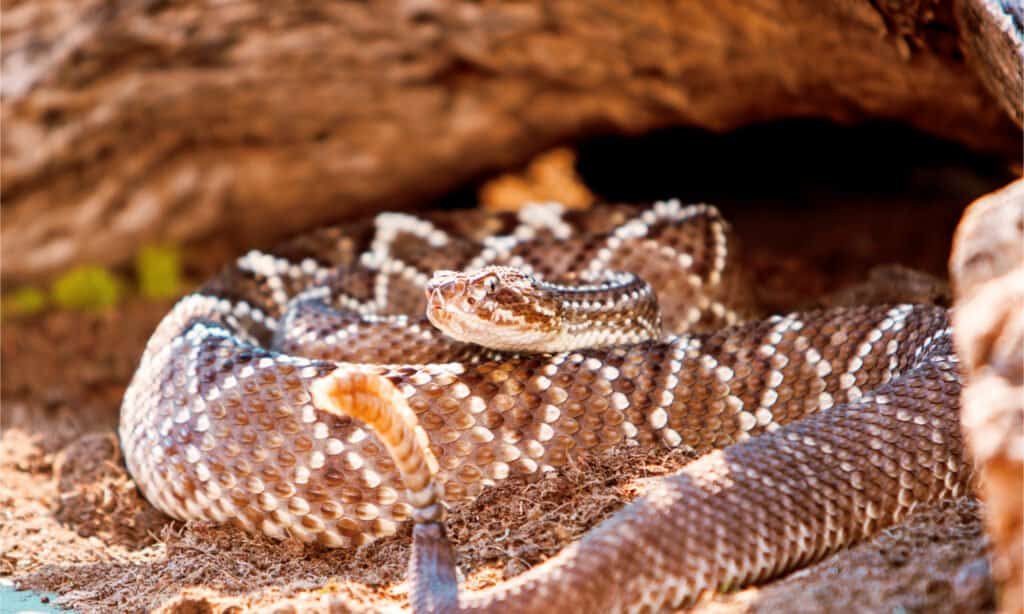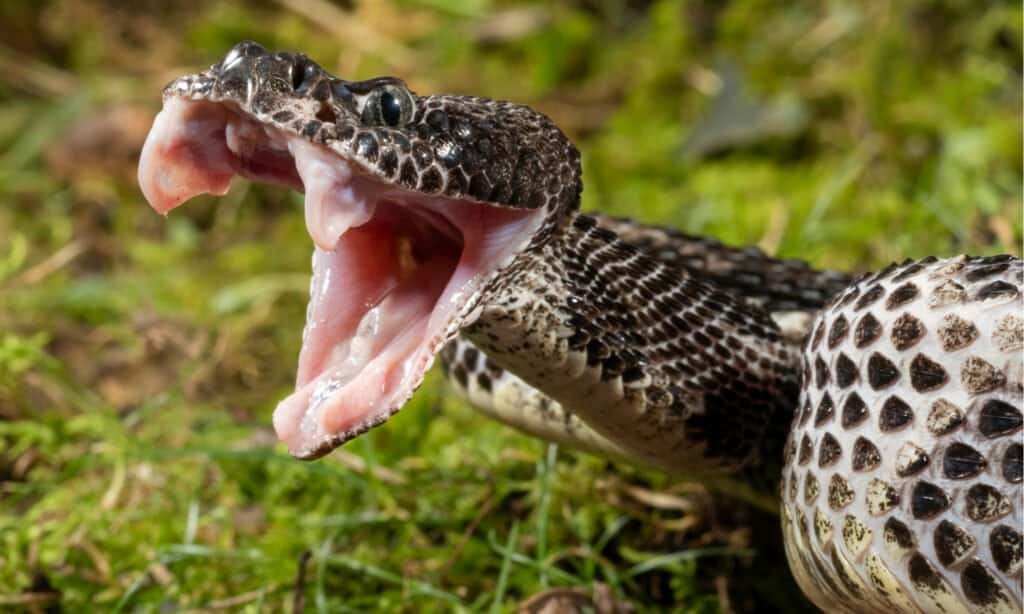Rattlesnakes are notorious predators with formidable fangs and incredible striking power. They’re often hidden out of sight just before an attack, catching their victim by total surprise. Bobcats are just as stealthy, but do they have the strength, agility, and strategy needed to make a victim of a venomous opponent? Let’s break down the details of a bobcat vs. rattlesnake match and determine who will win the fight.
Comparing a Bobcat and a Rattlesnake

| Bobcat | Rattlesnake | |
| Size | up to 40 lbs, 1-2 ft tall, 2.5-4 ft long | up to 10 lbs, up to 8 ft long |
| Movement & Speed | 25-30 mph, 12 ft pouncing distance | 2-3 mph, can accurately strike from a distance of 1/2 body length |
| Attack Method | Biting and striking with sharp canines and claws | Fangs that deliver venom |
| Defenses | Growl and scream, biting, clawing | Defensive open-mouthed display, Rattling tail, biting |
| Predatory behavior | Ambush predator | Ambush predator |
Key Differences between a Bobcat and a Rattlesnake

Rattlesnakes are venomous pit vipers with powerful fangs, while bobcats are predatory felines with sharp teeth and claws
©GoodFocused/Shutterstock.com
The main differences between the feline bobcat and the serpentine rattlesnake are their size, morphology, and attacking methods. Rattlesnakes are venomous pit vipers with a distinctive rattle at the end of their tails. The largest species of rattlesnake is the Eastern diamondback, which can grow to be up to 8 feet long and weigh 10 pounds (the largest on record weighed an astonishing 34 pounds!). Adult bobcats are generally 1 to 2 feet tall at the shoulder and 2.5 to 4 feet long. They weigh up to 40 pounds on average.
These differences would definitely make the battle of bobcat vs. rattlesnake interesting. However, we also need to look at other factors that will be specific to the outcome of a fight between these powerful predators.
What are the Key Factors in a Fight Between a Bobcat and a Rattlesnake?

Rattlesnakes can weigh up to 10 pounds but bobcats can grow to be 40 pounds
©Chase D’animulls/Shutterstock.com
Some key factors in a bobcat vs. rattlesnake fight would be their size, speed, and attacking methods. We also need to consider their physical defenses and predatory behavior to determine who would be victorious in this match.
Bobcat vs. Rattlesnake: Size
Rattlesnakes grow to a range of sizes, depending on the species. The timber rattlesnake is generally 2.5 to 5 feet long, but some can get up to 7 feet. As we already mentioned, the eastern diamondback is the largest rattlesnake species, growing up to 8 feet in length and weighing up to 10 pounds. Bobcats are typically 1 to 2 feet tall at the shoulder and 2.5 to 4 feet long. They weigh up to 40 pounds on average, but some have even weighed in at over 50 pounds.
Rattlesnakes can grow to be much longer than bobcats. But, when we consider overall size, bobcats are larger.
Bobcats have the weight advantage over rattlesnakes.
Bobcat vs. Rattlesnake: Movement & Speed

Rattlesnakes have extremely rapid striking force.
©Joe McDonald/Shutterstock.com
Bobcats are fast felines with an average speed of 25 to 30 miles per hour, topping out at 34 miles per hour. They’re able to take down prey with a powerful pounce from up to 12 feet away. Rattlesnakes are capable of an accurate and well-placed strike of about half their body length. So, if we consider an 8-foot rattlesnake, it can strike from 4 feet away. Rattlesnakes tend to move relatively slowly when not striking, with an average speed of 2 to 3 miles per hour.
Rattlesnakes have an impressive strike that happens in the blink of an eye. But overall, bobcats are faster and can attack from a much further distance.
The bobcat has the speed and movement advantage.
Bobcat vs. Rattlesnake: Attack Method
Bobcats are elusive predators that silently stalk their prey before pouncing with incredible force. They take advantage of their sharp hearing, quick moves and turns, as well as light-footed attacks. Bobcats bite into their prey with canines specially designed for the purpose. As heterodonts, they have a complete set of teeth, including incisors, canines, premolars, and molars. But the sharp canines grab prey and help them shear animal meat into bite-sized pieces. In addition to their bite, they have strong claws to tear into their opponent. Rattlesnakes attack by striking their prey and sinking their powerful fangs into their victim. The fangs deliver venom immediately, and it takes half a second for the snake to strike and paralyze prey.
Each has a powerful method of striking and biting into their opponent. However, the bobcat has the advantage of using its claws as an additional method of attack.
The bobcat has an attack advantage.
Bobcat vs. Rattlesnake: Physical Defenses

Southern Pacific rattlesnakes only take this posture when they sense a threat.
©Audrey Snider-Bell/Shutterstock.com
When rattlesnakes choose to stand their ground in a fight, they may display an open-mouthed, defensive position and shake their rattle. The rattle is a warning sign for others of the potential for a strike. If necessary, they may go straight into a biting attack, but they can only strike out powerfully from a coiled position. When bobcats feel threatened, they may give a ferocious growl or a high-pitched scream. They use their sharp teeth and claws, as well as their agile movements, to defend themselves against an attacker.
The bobcat has a defense advantage.
Bobcat vs. Rattlesnake: Predatory Behavior
As pit vipers, rattlesnakes have heat-sensing organs located near their eyes. These allow them to sense the heat signatures of animals around them. So even in the dark, they’d be able to strike accurately. They have a highly-developed organ or chemoreception called Jacobson’s organ. Rattlesnakes hunt by ambushing, meaning that they lie in wait until an unsuspecting victim crosses their path. Bobcats have extraordinary vision, especially at night. This is their primary means of hunting, but they also use their excellent sense of hearing. They’re able to tread lightly and approach their victims with the ultimate stealth. Also, ambush predators stalk their prey and catch them by surprise with a piercing death blow.
The bobcat’s method of silently stalking before the pounce differs from the sit-and-wait method of the rattlesnake. In the fight of bobcat vs. rattlesnake, this could have a significant effect on the outcome of the battle, depending on the conditions that led up to the interaction.
As far as predatory behavior, the bobcat and rattlesnake are well-matched.
Who Would Win in a Fight Between a Bobcat and a Rattlesnake?

Bobcats are larger and faster than rattlesnakes and have more methods of attack and defense.
©Fijetland, Conrad – Public Domain by US Fish & Wildlife Service, from Wikimedia Commons, the free media repository – License
A bobcat would be likely to win the fight with a rattlesnake. It’s possible that a rattlesnake could surprise the bobcat with a well-timed strike and deliver enough venom to take down the bobcat. However, we’ve just discussed the advantages the bobcat is working with. In this pairing, bobcats have the advantage of size, speed, attack method, and physical defense. As ambush predators with unique strategies leading up to the ambush, they’re well-matched up to the point of close contact.
If these predators were in close contact, head-to-head battle, the bobcat certainly has the advantage. Without time to recoil, the rattlesnake has limited strike potential. As the bobcat bobs and weaves in an agile dance around the rattlesnake, it would be able to dodge any attack. Its powerful claws could meet the rattlesnake’s every move. Once the rattlesnake has been worn down in the exchange, the bobcat can deliver the final blow. The victorious bobcat can tear apart the snake’s flesh and make a meal out of its opponent.
Who Could Beat a Bobcat in Battle?
Bobcats are known for their stealth and agility, which makes them powerful predators. However, some animals possess the strength and skills to give bobcats a challenge in battle. Bears have been known to stand up against bobcat attacks due to their superior size and strength. Wolves also have an edge over bobcats with their larger size, speed, and agility, which make them formidable opponents. A fight between these predators would be an intense match of wits and power as each creature attempts to outmaneuver the other until one is declared victorious. In such a scenario, both creatures could likely suffer injuries before one emerges victoriously from the clash of wills.
The photo featured at the top of this post is ©
Thank you for reading! Have some feedback for us? Contact the AZ Animals editorial team.






